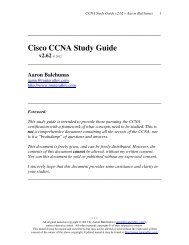Open Shortest Path First (OSPF) - Router Alley
Open Shortest Path First (OSPF) - Router Alley
Open Shortest Path First (OSPF) - Router Alley
Create successful ePaper yourself
Turn your PDF publications into a flip-book with our unique Google optimized e-Paper software.
<strong>OSPF</strong> v1.31 – Aaron Balchunas<br />
3<br />
<strong>OSPF</strong> Neighbors (continued)<br />
<strong>OSPF</strong> routers will only become neighbors if the following parameters within<br />
a Hello packet are identical on each router:<br />
• Area ID<br />
• Area Type (stub, NSSA, etc.)<br />
• Prefix<br />
• Subnet Mask<br />
• Hello Interval<br />
• Dead Interval<br />
• Network Type (broadcast, point-to-point, etc.)<br />
• Authentication<br />
The Hello packets also serve as keepalives to allow routers to quickly<br />
discover if a neighbor is down. Hello packets also contain a neighbor field<br />
that lists the <strong>Router</strong> IDs of all neighbors the router is connected to.<br />
A neighbor table is constructed from the <strong>OSPF</strong> Hello packets, which<br />
includes the following information:<br />
• The <strong>Router</strong> ID of each neighboring router<br />
• The current “state” of each neighboring router<br />
• The interface directly connecting to each neighbor<br />
• The IP address of the remote interface of each neighbor<br />
(Reference: http://www.cisco.com/warp/public/104/29.html)<br />
* * *<br />
All original material copyright © 2007 by Aaron Balchunas (aaron@routeralley.com),<br />
unless otherwise noted. All other material copyright © of their respective owners.<br />
This material may be copied and used freely, but may not be altered or sold without the expressed written<br />
consent of the owner of the above copyright. Updated material may be found at http://www.routeralley.com.

















